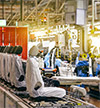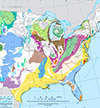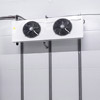When Nestlé USA began evaluating potential sites for a new beverage manufacturing and distribution center, the company wasn’t just looking for space—they were looking for speed, flexibility, and long-term sustainability. Glendale, Arizona delivered all three.
In January 2025, Nestlé officially opened a $675 million, 630,000-square-foot facility that now produces more than 50 flavors of Coffee mate®, natural bliss®, and Starbucks® creamers. The project created 300 jobs and positioned Nestlé closer to West Coast customers—but what makes it stand out is how advanced the facility is, and how quickly the city helped bring it online.
Robotics, Rapid Changeover, and Cleanroom Efficiency
From the start, Nestlé designed the Glendale facility with flexibility and precision automation in mind. According to city building official Djordje Pavlovic, the plant can switch between dozens of flavor profiles with minimal downtime, thanks to an internal sanitary piping system and efficient changeover protocols.
“You throw whatever flavor you want, they’ll make sure that in a week you’ll get that creamer,” said Pavlovic. “They can produce any beverage that they have in that facility with basically just a little bit of the tweaking in the industrial engineering component.”
What’s more, the facility operates almost like a cleanroom. Human activity is limited to designated zones, while an array of autonomous systems handles mixing, filling, bottling, labeling, wrapping, and storing. The building includes a 120-foot-tall automated storage and retrieval system (ASRS) served by robotic vehicles. “Once you get into the manufacturing, the humans are in the part where they actually do their patented mixes,” said Randy Huggins Jr., who managed the project for Glendale during site selection and development. “But then it runs in, when the materials go into the facility, it becomes 100% automated.”
Water Recycling: A Last-Minute but Lasting Sustainability Solution
Originally, Nestlé had not planned to build its own water recycling system—but when local utility EPCOR raised concerns about sewer discharge limits, the company responded with a game-changing addition: a self-contained water reuse facility.
“They are right now discharging about 5% max from the facility,” said Pavlovic. “The rest is being used for air conditioning, cooling systems, and irrigation—so very energy efficient.”
This infrastructure now supports not just the existing operations, but also future expansions already envisioned on the south side of the site. It also reflects Nestlé’s broader goal to reduce environmental impact across its global footprint.
Speed by Design
Nestlé first contacted Glendale through the Greater Phoenix Economic Council and the Arizona Commerce Authority in early 2021. By mid-year, they had selected the site. The city moved quickly—offering an expedited permitting process, phasing flexibility, and creative solutions like an “at-risk agreement” that allowed early construction work on geotechnical foundations.
Glendale also developed a unique “hostage permit” strategy to allow phased occupancy while ensuring remaining site work stayed on track. “We had to make sure that once employees come and start doing their work and testing… we don’t want them to interfere with construction, or construction workers to interfere with the operations,” said Pavlovic.
From Jet Noise to Jobs
Glendale’s economic development team wasn’t sure if Nestlé’s would have concerns about proximity to Luke Air Force Base, so they addressed it head on and turned it into an advantage. “The very first thing we did when we met them is we introduced Luke Air Force Base,” said Huggins. “We invited Nestlé and Luke to meet us at the Luke Air Force Base golf course, and we talked about the ways the two could actually partner.”
Through the Department of Defense’s SkillBridge program, airmen transitioning out of service—as well as their spouses and family members—are now being connected to manufacturing roles at the facility.
From automation and water reuse to workforce integration and speed to market, Nestlé’s Glendale plant represents more than a capital investment—it’s a blueprint.




